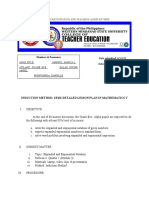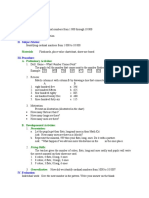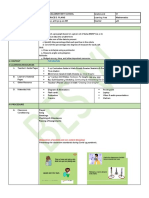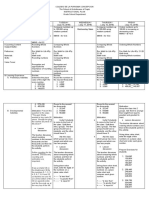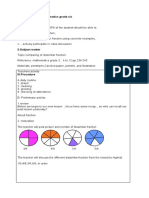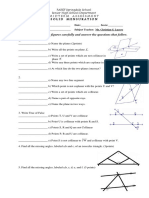Lesson Plan in Mathematics Iv
Lesson Plan in Mathematics Iv
Uploaded by
Nhabz TanCopyright:
Available Formats
Lesson Plan in Mathematics Iv
Lesson Plan in Mathematics Iv
Uploaded by
Nhabz TanOriginal Description:
Original Title
Copyright
Available Formats
Share this document
Did you find this document useful?
Is this content inappropriate?
Copyright:
Available Formats
Lesson Plan in Mathematics Iv
Lesson Plan in Mathematics Iv
Uploaded by
Nhabz TanCopyright:
Available Formats
LESSON PLAN IN MATHEMATICS IV
October 28 – 29, 2019
I – OBJECTIVE
Describe parallel, intersecting, and perpendicular lines.
Illustrate parallel, intersecting, and perpendicular lines.
II – SUBJECT MATTER
Topic: Identifying Parallel, Intersecting, and Perpendicular Lines
Materials: Illustrations of parallel, intersecting, and perpendicular lines, cutouts of lines,
drawings of pairs of line segments, ruler, set square
References: K to 12 Grade 4 Curriculum Guide, LM Math Grade 4 pages 155 and 156
Value Focus: Orderliness
Prerequisite Concept and Skills:
Recognizing a point, line segment, and ray
III – INSTRUCTIONAL PROCEDURE
A. Preliminary Activities
1. Drill
Have a drill on identifying points, line segments, rays, and lines using flash cards
with geometric figures. After the activity, ask pupils to give a representation of points,
line segments, rays, and lines. Also provide exercise on naming points, lines, line
segment, and rays.
2. Review
Game: “What Am I?”
a. I have an exact location in space. I am represented by a dot. (point)
b. I have no endpoint and I can go on and on in opposite directions. (line)
c. I start out at a point and can be extended in one direction. (ray)
d. I am a part of a line with 2 endpoints. (line segment)
3. Motivation
Say: Picture yourself in front of the flagpole forming lines for the flag raising
ceremony. How should you form your lines?
Relate the value of orderliness in forming their lines during flag ceremony.
B. Developmental Activities
1. Presentation
Have a game on “Forming Lines”. Let them form different kinds of lines
depending on the instruction given.
a. All those whose birth month is June will form 2 straight lines.
b. All those who are wearing T-shirts will form 2 lines that meet at the center.
c. All those whose birth month is March will form one line and another line for those
who were born in August. Then, form 2 lines that show square corners.
2. Performing the Activities
Group the pupils into six teams. Ask each group to work together in illustrating
the given figures to show the different kinds of lines using cutouts.
Group 1: Crossroads
Group 2: Time using hands of the clock
Group 3: Designs of a ceiling
Group 4: Design of a T-shirt
Group 5: Electronic posts
Group 6: Window panes
After all the groups have finished, ask them to display their outputs on the board.
Let them tell something about the figures that they formed and what kind of lines
each figure shows.
3. Processing the Activities
After all groups have presented their output, ask: “How did you find the activity?
How were you able to illustrate the figure given to you? Did you cooperate with your
group mates?”
Discuss with the pupils the different kinds of lines, namely: parallel, intersecting,
and perpendicular lines. Show them the different symbols used to represent each
kind of lines.
4. Reinforcing the Concept and Skill
Discuss the presentation under Explore and Discover on page 155 of LM Math
Grade 4.
Have the pupils to answer the items under Get Moving on page 155 LM Math
Grade 4.
To further reinforce the skill, ask the pupils to answer the items under Keep
Moving on page 156 of LM Math Grade 4.
5. Summarizing the Lesson
Lead the pupils in generalizing what parallel lines, intersecting lines, and
perpendicular lines are.
Parallel lines are lines that do not meet.
Intersecting lines are lines that cross each other.
Perpendicular lines are lines that intersect and form square corners.
IV – EVALUATION
Draw a circle for parallel lines, triangle for intersecting lines, and rectangle for
perpendicular lines.
1. 2. 3. 4. 5.
V – ASSIGNMENT
Illustrate parallel lines, intersecting lines, and perpendicular lines in a one whole sheet of bond
paper.
You might also like
- Detailed Lesson Plan in Mathematics IIIDocument5 pagesDetailed Lesson Plan in Mathematics IIIMYLAH GERENANo ratings yet
- A Detailed Lesson Plan in Mathematics VDocument3 pagesA Detailed Lesson Plan in Mathematics VFemJabagat89% (36)
- Identifying Parallel, Intersecting and Perpendicular LinesDocument2 pagesIdentifying Parallel, Intersecting and Perpendicular LinesCRISTY JOY SOTOMAYOR100% (2)
- Lesson 48 Day 1 LCTGDocument5 pagesLesson 48 Day 1 LCTGRia Fineen G TorresNo ratings yet
- Math 3 Lesson PlanDocument4 pagesMath 3 Lesson PlanEloyd UngadNo ratings yet
- Describe and Illustrates Parallel, Intersecting and Perpendicular Lines. (M4Ge-Iiia-12.2)Document5 pagesDescribe and Illustrates Parallel, Intersecting and Perpendicular Lines. (M4Ge-Iiia-12.2)Jade Ann II100% (1)
- Math2 Q3 W8-10Document59 pagesMath2 Q3 W8-10Jerick JohnNo ratings yet
- I. Objectives: Detailed Lesson Plan in Mathematics IVDocument5 pagesI. Objectives: Detailed Lesson Plan in Mathematics IVJB JobianeNo ratings yet
- Lesson Plan in Mathematics VIDocument2 pagesLesson Plan in Mathematics VIarvin tocino100% (1)
- Grade 4 Lesson 74 Interpreting Data Presented in Single Vertical and Horizontal Bar Graphs MarvietblancoDocument17 pagesGrade 4 Lesson 74 Interpreting Data Presented in Single Vertical and Horizontal Bar Graphs MarvietblancoHenry EsquivelNo ratings yet
- Lesson - Double Bar GraphDocument3 pagesLesson - Double Bar Graphapi-382694630No ratings yet
- Semi Detailed LP For Grade V MathDocument7 pagesSemi Detailed LP For Grade V MathDivine Angel Baddiri SalasNo ratings yet
- Lesson Plan 1Document2 pagesLesson Plan 1api-238166786No ratings yet
- Ordering Whole Numbers Lesson PlanDocument3 pagesOrdering Whole Numbers Lesson Planapi-490791018No ratings yet
- Math3 Q1 Week3 Day1-5Document45 pagesMath3 Q1 Week3 Day1-5frances kathleen licos100% (1)
- Associative Property Lesson PlanDocument11 pagesAssociative Property Lesson Planapi-299458957No ratings yet
- Lesson Plan in Mathematics 4Document3 pagesLesson Plan in Mathematics 4Sarah Jean R. RabanzoNo ratings yet
- Lesson 74 Interpreting Data Presented in Horizontal Bar GraphsDocument15 pagesLesson 74 Interpreting Data Presented in Horizontal Bar GraphsANNALYN OMONo ratings yet
- LP 3Document6 pagesLP 3Ayessa BantaoNo ratings yet
- Simplify Fractions - Lesson PlanDocument2 pagesSimplify Fractions - Lesson Planmsdoramia100% (1)
- LP in IDENTIFYING PARALLEL, INTERSECTING AND PERPENDICULAR LINESDocument8 pagesLP in IDENTIFYING PARALLEL, INTERSECTING AND PERPENDICULAR LINESGlory Jane Luzara100% (1)
- DLL - Mathematics 4 - Q3 - W2Document3 pagesDLL - Mathematics 4 - Q3 - W2Rigino MacunayNo ratings yet
- DLP - Mathematics 3 - Q1-Q4Document224 pagesDLP - Mathematics 3 - Q1-Q4Apple DocasaoNo ratings yet
- DARYLENE QUEEN G. SERRANO BEED-4A Lesson PlanDocument3 pagesDARYLENE QUEEN G. SERRANO BEED-4A Lesson PlanJennifer Bernas BerdulNo ratings yet
- Findingthe Areaofa TriangleDocument7 pagesFindingthe Areaofa TriangleJay Anne Legaspi Dumam-agNo ratings yet
- Knowledge:: Grade 6 Lesson Plan Balatikan Elementary School VI Shernie Grace D. Plang Mathematics 4th I ObjectivesDocument7 pagesKnowledge:: Grade 6 Lesson Plan Balatikan Elementary School VI Shernie Grace D. Plang Mathematics 4th I ObjectivesShernie Grace PlangNo ratings yet
- Math Lesson Plan - Finding PerimeterDocument12 pagesMath Lesson Plan - Finding Perimeterapi-302768850No ratings yet
- Lesson Plan 4Document23 pagesLesson Plan 4Jay BolanoNo ratings yet
- Math4-Q3-W4 PresentationDocument41 pagesMath4-Q3-W4 PresentationSherina LinangNo ratings yet
- Lesson Plan in Mathematics - Area Concept1Document2 pagesLesson Plan in Mathematics - Area Concept1Edelmar Benosa100% (5)
- Mathematics 4 DLP For COT1Document5 pagesMathematics 4 DLP For COT1Re BornNo ratings yet
- Lesson Plan in Mathematics IvDocument5 pagesLesson Plan in Mathematics IvPamela RebuyasNo ratings yet
- Math4, SLHT, Q3, WK 3 M4GE IIIc 17Document5 pagesMath4, SLHT, Q3, WK 3 M4GE IIIc 17Elmer ArnadoNo ratings yet
- A Detailed Lesson Plan in Mathematics I. ObjectivesDocument10 pagesA Detailed Lesson Plan in Mathematics I. ObjectivesDanielle Alarcon CruzNo ratings yet
- Lesson Plan I. Learning ObjectivesDocument4 pagesLesson Plan I. Learning ObjectivesChrishela Patarata Casa Gonzales0% (1)
- A Demonstration Lesson PlanDocument9 pagesA Demonstration Lesson PlanSylvia Estoesta100% (1)
- Create Figures That Shows Symmetry in A LineDocument4 pagesCreate Figures That Shows Symmetry in A LineDina ReclaNo ratings yet
- Lesson Plan Grade 4Document8 pagesLesson Plan Grade 4Ma. Vicenta FerrerNo ratings yet
- Lesson Plan in MathDocument3 pagesLesson Plan in MathJaylord LosabiaNo ratings yet
- Lesson Plan in Mathematics 1Document3 pagesLesson Plan in Mathematics 1Inuyashayahoo100% (1)
- Detailed Lesson Plan in MathematicsDocument12 pagesDetailed Lesson Plan in MathematicsCMarie Cachero Paz50% (2)
- DLP Angle MeasurementDocument6 pagesDLP Angle MeasurementJane Dell CaparoNo ratings yet
- Revised Lesson PlanDocument7 pagesRevised Lesson PlanAnanda Del CastilloNo ratings yet
- Math4 LessonPlanDocument10 pagesMath4 LessonPlanTorres, Emery D.100% (1)
- DLL - Math 5 - Q1 - W1Document5 pagesDLL - Math 5 - Q1 - W1Yzanariz VillaruelNo ratings yet
- Semi Detailed Lesson Plan in Math 6Document3 pagesSemi Detailed Lesson Plan in Math 6Nyca PacisNo ratings yet
- A Detailed Lesson Plan in Grade 4 MathematicsDocument8 pagesA Detailed Lesson Plan in Grade 4 MathematicsDiane joy ClaudioNo ratings yet
- 3rd Quarter - Math 5 - Summative Test No.2Document3 pages3rd Quarter - Math 5 - Summative Test No.2Yanne VillanuevaNo ratings yet
- School Mendez Central School Grade Level Four Teacher Jonalyn E. Perido Learning Area Mathematics Teaching Date and Time Quarter FirstDocument8 pagesSchool Mendez Central School Grade Level Four Teacher Jonalyn E. Perido Learning Area Mathematics Teaching Date and Time Quarter FirstPapa Dudot PallerNo ratings yet
- Math 5 DLP - Q3 W3d1 5Document15 pagesMath 5 DLP - Q3 W3d1 5Maryjoy RiveraNo ratings yet
- Order of Operations Lesson PlanDocument4 pagesOrder of Operations Lesson Planapi-669076024No ratings yet
- MATH DLL For Grade 4Document5 pagesMATH DLL For Grade 4Kathie LawrenceNo ratings yet
- Math 4 Q3 Lesson 52 Describing QuadrilateralsDocument60 pagesMath 4 Q3 Lesson 52 Describing QuadrilateralsRossel SalmoroNo ratings yet
- MATH3 Q3 Mod 8 SymmetryDocument9 pagesMATH3 Q3 Mod 8 SymmetryLouie Raff Michael EstradaNo ratings yet
- Detailed Lesson Plan I. Objective: Value Focus: Healthy LifestyleDocument7 pagesDetailed Lesson Plan I. Objective: Value Focus: Healthy LifestyleMary Ann Firmeza Albestor100% (1)
- Dlp-Math 4Document6 pagesDlp-Math 4RICHELLE GEQUINTONo ratings yet
- English 3 - Plural Form of Regular NounsDocument30 pagesEnglish 3 - Plural Form of Regular NounsMARY ANTONETTE JUANNo ratings yet
- Semi-Detailed Lesson Plan in Mathematics Grade 4Document6 pagesSemi-Detailed Lesson Plan in Mathematics Grade 4Marlon SalasNo ratings yet
- Roman Numerals LPDocument5 pagesRoman Numerals LPapi-315857509No ratings yet
- Lesson Plan For Mathematics Grade 6 NewDocument3 pagesLesson Plan For Mathematics Grade 6 NewJM INOCENTE CALANAONo ratings yet
- Elementary School ‘Grades 1 & 2: Math – Number – Ages 6-8’ eBookFrom EverandElementary School ‘Grades 1 & 2: Math – Number – Ages 6-8’ eBookNo ratings yet
- Magical Shortcut Methods For Competitive Exam (300 To 400)Document20 pagesMagical Shortcut Methods For Competitive Exam (300 To 400)Ujwal kumar100% (1)
- Mste 2.0 Trigonometry Hand OutsDocument11 pagesMste 2.0 Trigonometry Hand OutsJasmine MartinezNo ratings yet
- Imo - Sof International Mathematics Olympiad Past Year Paper - 2010Document10 pagesImo - Sof International Mathematics Olympiad Past Year Paper - 2010Amit KumarNo ratings yet
- NcertDocument22 pagesNcertJEENUPRIYA SAHANo ratings yet
- Area of Oblique TrianglesDocument14 pagesArea of Oblique TrianglesDaryann Mae ImperialNo ratings yet
- A Generalization of Sawayama Lemma and Sawayama - Thebault TheoremDocument3 pagesA Generalization of Sawayama Lemma and Sawayama - Thebault TheoremSaran VijaiNo ratings yet
- Latitude and Longitudes in GeodesyDocument6 pagesLatitude and Longitudes in GeodesyAbdo SaeedNo ratings yet
- Mensuration Problems1Document16 pagesMensuration Problems1Tapas BanerjeeNo ratings yet
- QethDocument100 pagesQethAbchoNo ratings yet
- Area of A Quadrilateral Calculator - High Accuracy CalculationllDocument2 pagesArea of A Quadrilateral Calculator - High Accuracy CalculationllFAROOKNo ratings yet
- IM Statics Module 1 3 4Document21 pagesIM Statics Module 1 3 4Lloyd MontemayorNo ratings yet
- Conic Ho DgoDocument9 pagesConic Ho DgoBubu DroidNo ratings yet
- OSM ConsolEx 4B11 11b lv2 E-1Document4 pagesOSM ConsolEx 4B11 11b lv2 E-1mikeeeerrNo ratings yet
- MTH301 MIDTERM SOLVED MCQS by JUNAIDDocument24 pagesMTH301 MIDTERM SOLVED MCQS by JUNAIDsaimrajpoot7512100% (1)
- Geometry ProofsDocument4 pagesGeometry Proofsgauravkalra43No ratings yet
- X - Cbse Maths Pre-Mid Term Exam - FinalDocument7 pagesX - Cbse Maths Pre-Mid Term Exam - FinalmizukiNo ratings yet
- City Design ProjectDocument2 pagesCity Design ProjectwjmenardNo ratings yet
- 04 Indices and SurdsDocument26 pages04 Indices and SurdsChitrah LcNo ratings yet
- Aops Community 2004 National Olympiad First RoundDocument5 pagesAops Community 2004 National Olympiad First RoundQFDqNo ratings yet
- Straight Line Quiz 1Document3 pagesStraight Line Quiz 1Arun SharmaNo ratings yet
- Midterm Assessment-Solid MensurationDocument4 pagesMidterm Assessment-Solid MensurationChristianLuceroNo ratings yet
- History of Trigonometry: With Classroom ApplicationsDocument70 pagesHistory of Trigonometry: With Classroom ApplicationsAnnisa Musvita SariNo ratings yet
- Circle Theorem 3Document2 pagesCircle Theorem 3yaw197No ratings yet
- Math 71 Chapter 1 HandoutsDocument24 pagesMath 71 Chapter 1 HandoutsLJ PCNo ratings yet
- Parallel Lines Cut by TransversalDocument20 pagesParallel Lines Cut by Transversalhoneybal egiptoNo ratings yet
- 7 MathsDocument3 pages7 MathsMuraliNo ratings yet
- 04 - Tangent LinesDocument2 pages04 - Tangent LinesSky DiamondNo ratings yet
- JIM419 13-Tutorial2 SolutionDocument5 pagesJIM419 13-Tutorial2 Solutionmeshi1984No ratings yet
- Map Scales and Bearing PPT - 15.27.08Document20 pagesMap Scales and Bearing PPT - 15.27.08Kelvin Lau100% (1)











